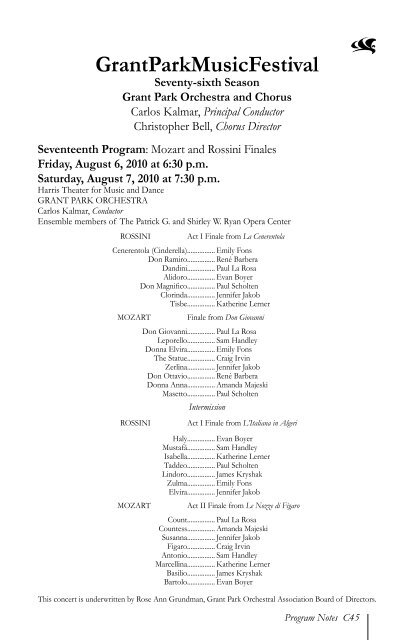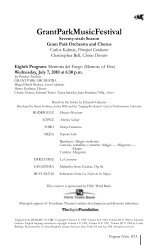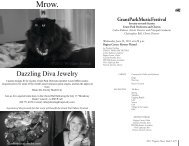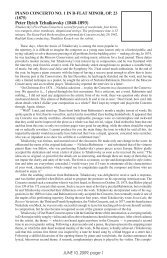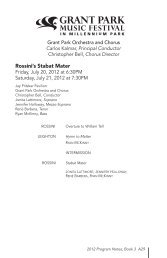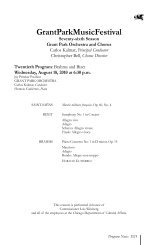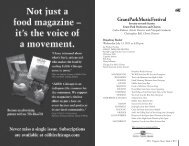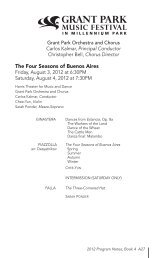Program Notes PDF - The Grant Park Music Festival
Program Notes PDF - The Grant Park Music Festival
Program Notes PDF - The Grant Park Music Festival
Create successful ePaper yourself
Turn your PDF publications into a flip-book with our unique Google optimized e-Paper software.
<strong>Grant</strong><strong>Park</strong><strong>Music</strong><strong>Festival</strong><br />
Seventy-sixth Season<br />
<strong>Grant</strong> <strong>Park</strong> Orchestra and Chorus<br />
Carlos Kalmar, Principal Conductor<br />
Christopher Bell, Chorus Director<br />
Seventeenth <strong>Program</strong>: Mozart and Rossini Finales<br />
Friday, August 6, 2010 at 6:30 p.m.<br />
Saturday, August 7, 2010 at 7:30 p.m.<br />
Harris <strong>The</strong>ater for <strong>Music</strong> and Dance<br />
GRANT PARK ORCHESTRA<br />
Carlos Kalmar, Conductor<br />
Ensemble members of <strong>The</strong> Patrick G. and Shirley W. Ryan Opera Center<br />
ROSSINI Act I Finale from La Cenerentola<br />
Cenerentola (Cinderella)................ Emily Fons<br />
Don Ramiro................ René Barbera<br />
Dandini................ Paul La Rosa<br />
Alidoro................ Evan Boyer<br />
Don Magnifico................ Paul Scholten<br />
Clorinda................ Jennifer Jakob<br />
Tisbe................ Katherine Lerner<br />
MOZART Finale from Don Giovanni<br />
Don Giovanni................ Paul La Rosa<br />
Leporello................ Sam Handley<br />
Donna Elvira................ Emily Fons<br />
<strong>The</strong> Statue................ Craig Irvin<br />
Zerlina................ Jennifer Jakob<br />
Don Ottavio................ René Barbera<br />
Donna Anna................ Amanda Majeski<br />
Masetto................ Paul Scholten<br />
Intermission<br />
ROSSINI Act I Finale from L’Italiana in Algeri<br />
Haly................ Evan Boyer<br />
Mustafá................ Sam Handley<br />
Isabella................ Katherine Lerner<br />
Taddeo................ Paul Scholten<br />
Lindoro................ James Kryshak<br />
Zulma................ Emily Fons<br />
Elvira................ Jennifer Jakob<br />
MOZART Act II Finale from Le Nozze di Figaro<br />
Count................ Paul La Rosa<br />
Countess................ Amanda Majeski<br />
Susanna................ Jennifer Jakob<br />
Figaro................ Craig Irvin<br />
Antonio................ Sam Handley<br />
Marcellina................ Katherine Lerner<br />
Basilio................ James Kryshak<br />
Bartolo................ Evan Boyer<br />
This concert is underwritten by Rose Ann Grundman, <strong>Grant</strong> <strong>Park</strong> Orchestral Association Board of Directors.<br />
<strong>Program</strong> <strong>Notes</strong> C45
GRANT PARK MUSIC FESTIVAL Friday, August 6 and Saturday, August 7, 2010<br />
THE PATRICK G. AND SHIRLEY W. RYAN OPERA CENTER was established in<br />
1974 as the professional artist-development program for Lyric Opera of Chicago. Since its inception,<br />
the Ryan Opera Center has been recognized as one of the premier programs of its kind in<br />
the world. That standing is maintained by providing the finest up-and-coming singers with unparalleled<br />
training and experience. Gianna Rolandi is Director of the program. Selected from some 400<br />
singers who audition annually, the Ryan Opera Center Ensemble members are in residence for<br />
twelve months. Over the course of the year, they receive advanced instruction in numerous aspects<br />
of operatic performance, including voice lessons and coaching, language and acting training, and<br />
master classes with some of opera’s most renowned artists. Ensemble members gain valuable performing<br />
experience by participating in recitals and concerts at many Chicago-area venues. During<br />
Lyric Opera’s mainstage season, they perform and understudy roles at all levels. This presents an<br />
extraordinary opportunity to work with the world’s greatest opera singers, conductors, directors,<br />
orchestra and chorus. <strong>The</strong> Ryan Opera Center’s distinguished alumni include Harolyn Blackwell,<br />
Nicole Cabell, David Cangelosi, Mark S. Doss, Christopher Feigum, Elizabeth Futral, Roger Honeywell,<br />
Joseph Kaiser, Maria Kanyova, Quinn Kelsey, Dina Kuznetsova, Gary Lehman, Emily Magee,<br />
Marlin Miller, Susanna Phillips, Matthew Polenzani, Amber Wagner, Erin Wall, and Guang Yang.<br />
Tenor RENÉ BARBERA, a second-year Ryan Opera Center member,<br />
was a winner of the 2008 Metropolitan Opera National Council Auditions<br />
Grand Finals. A native of San Antonio, Texas, Mr. Barbera is a<br />
former participant in the young-artist programs of San Francisco Opera<br />
(Merola <strong>Program</strong>) and Florida Grand Opera. His awards include first<br />
place in the Union League Civic and Arts Foundation competition. After<br />
performing in the 2009 “Stars of Lyric Opera at Millennium <strong>Park</strong>” concert,<br />
Mr. Barbera debuted at Lyric Opera of Chicago as Riccardo in Ernani,<br />
later singing Nemorino in L’Elisir d’Amore (student matinees). During<br />
spring 2010, he appeared with the Greensboro Symphony, and this season<br />
at Lyric Opera he will be seen in Carmen, A Masked Ball, <strong>The</strong> Girl of the Golden West and Lohengrin.<br />
Bass-baritone EVAN BOYER is a first-year Ryan Opera Center<br />
member. In 2009 the Louisville, Kentucky native was a national semi-finalist<br />
in the Metropolitan Opera National Council Auditions. He recently<br />
completed studies at Philadelphia’s Curtis Institute of <strong>Music</strong>, where he<br />
performed in La Sonnambula, Antony and Cleopatra, <strong>The</strong> Rake’s Progress, Don<br />
Giovanni, Wozzeck and Le Nozze di Figaro. Mr. Boyer is a former participant<br />
in San Francisco Opera’s Merola <strong>Program</strong> and the Chautauqua Institution,<br />
and a former Tanglewood <strong>Music</strong> Center Fellow. He performed Oreste<br />
in Cavalli’s Giasone at Chicago Opera <strong>The</strong>ater during its spring 2010 season.<br />
Mr. Boyer makes his Lyric Opera of Chicago debut in the 2010-2011<br />
season in Macbeth, later appearing in <strong>The</strong> Girl of the Golden West, Lohengrin and Carmen (student<br />
matinees).<br />
Mezzo-soprano EMILY FONS, a native of Milwaukee and a first-year<br />
Ryan Opera Center member, was a Santa Fe Opera apprentice artist for<br />
two summers and sang Flora in La Traviata there last year. She previously<br />
participated in the Indianapolis Opera young artist program, appearing in<br />
Hänsel und Gretel and <strong>The</strong> Pirates of Penzance. Ms. Fons received her master’s<br />
degree from Southern Illinois University, where she performed Hansel in<br />
Hansel and Gretel and Angelica in Suor Angelica. Her other performances<br />
include the University of Miami’s “Summer in Salzburg” program and the<br />
Oberlin Baroque Performance Institute. Ms. Fons was a regional winner<br />
in the 2010 Metropolitan Opera National Council Auditions. During the<br />
Lyric Opera of Chicago 2010-2011 season, she will sing Mercédès in Carmen (her debut with the<br />
company), Peep-Bo in <strong>The</strong> Mikado and a Page in Lohengrin.<br />
C46 <strong>Program</strong> <strong>Notes</strong>
GRANT PARK MUSIC FESTIVAL Friday, August 6 and Saturday, August 7, 2010<br />
Bass-baritone SAM HANDLEY, a third-year Ryan Opera Center<br />
member, has appeared as Don Magnifico in La Cenerentola (San Francisco<br />
Opera’s Merola Opera <strong>Program</strong>) and in the title role in Don Pasquale (Santa<br />
Fe Opera tour). <strong>The</strong> Tennessee native has been a guest artist with the<br />
Houston Symphony Orchestra, Nashville Symphony and National Symphony<br />
Orchestra. Mr. Handley is a former participant in the young-artist<br />
program of the Santa Fe Opera. At Lyric Opera of Chicago, he made his<br />
debut in Manon and has since appeared in Madama Butterfly, Tosca and as<br />
Dulcamara in L’Elisir d’Amore (student matinees). He will be seen at Lorin<br />
Maazel’s Castleton <strong>Festival</strong> this summer. During the 2010-2011 Lyric Opera season he will perform<br />
in Macbeth, A Midsummer Night’s Dream, A Masked Ball, <strong>The</strong> Girl of the Golden West and Lohengrin.<br />
Bass-baritone CRAIG IRVIN, a third-year Ryan Opera Center member,<br />
has been heard with Naples Opera, Orlando Opera, Augusta Opera<br />
and Des Moines Metro Opera. A winner of the Heinz Rehfuss Singing<br />
Actor Award sponsored by Orlando Opera, he spent two seasons with that<br />
company as a resident artist. <strong>The</strong> Iowa native is an alumnus of Simpson<br />
College in Indianola and the University of Tennessee. Mr. Irvin’s recent<br />
concert engagements include the Elmhurst Symphony. He has appeared<br />
at Lyric Opera of Chicago in Manon, Lulu, Madama Butterfly and Tosca. This<br />
spring he portrayed Basilio in Il Barbiere di Siviglia with Knoxville Opera<br />
and returned to Des Moines for the title role in Le Nozze di Figaro. His<br />
appearances during Lyric Opera’s 2010-2011 season include Carmen, A Midsummer Night’s Dream, A<br />
Masked Ball and <strong>The</strong> Girl of the Golden West.<br />
Soprano JENNIFER JAKOB is a first-year Ryan Opera Center<br />
member. While completing her master’s degree at Indiana University, she<br />
appeared in La Rondine, Die Lustigen Weiber von Windsor and A Wedding. Ms.<br />
Jakob is a former member the Gerdine Young Artist <strong>Program</strong> of Opera<br />
<strong>The</strong>atre of Saint Louis and was recently an Apprentice Singer with the<br />
Santa Fe Opera. A native of Kempten, Germany, she has been featured<br />
with the Santa Fe Symphony, Newark Symphony Orchestra, and in the<br />
Sheldon Classics Series in St. Louis. Ms. Jakob won second place in the<br />
Midwest Region of the Metropolitan Opera National Council Auditions<br />
and has received awards from the Santa Fe Opera and the <strong>Music</strong>ians Club<br />
of Women. She appears during Lyric Opera’s 2010-2011 season in Macbeth (debut), Carmen and<br />
Lohengrin.<br />
Tenor JAMES KRYSHAK, a native of Baldwinsville, New York, is<br />
a first-year Ryan Opera Center member. His roles include Don Ottavio<br />
in Don Giovanni, Count Almaviva in Il Barbiere di Siviglia, Ernesto in Don<br />
Pasquale, Nanki-Poo in <strong>The</strong> Mikado, Camille in <strong>The</strong> Merry Widow, Frederic<br />
in <strong>The</strong> Pirates of Penzance, Tamino in Die Zauberflöte and Pelléas in Pelléas et<br />
Mélisande. During the summer of 2009, Mr. Kryshak was a Collier Young<br />
Artist at Des Moines Metro Opera. He was a national semi-finalist in the<br />
2009 Metropolitan Opera National Council Auditions. His concert engagements<br />
include the Czech National Symphony. Kryshak will make his<br />
Lyric Opera debut in the upcoming season’s A Midsummer Night’s Dream<br />
and also appears in A Masked Ball, <strong>The</strong> Girl of the Golden West and Lohengrin. Mr. Kryshak holds a<br />
master’s degree from the University of Wisconsin-Madison.<br />
C48 <strong>Program</strong> <strong>Notes</strong>
GRANT PARK MUSIC FESTIVAL Friday, August 6 and Saturday, August 7, 2010<br />
Baritone PAUL LA ROSA, a second-year Ryan Opera Center member<br />
from Union, New Jersey, was recently a member of the Juilliard Opera<br />
Center (Krenek’s Die Ehre der Nation, James Conlon conducting; John<br />
Adams’s <strong>The</strong> Death of Klinghoffer, under the composer’s baton). Mr. La Rosa<br />
was a 2008 Young Artist at Glimmerglass Opera (Curio in Giulio Cesare)<br />
and previously participated in San Francisco Opera’s Merola <strong>Program</strong><br />
(Dandini in La Cenerentola). He portrayed Junius in Britten’s <strong>The</strong> Rape of<br />
Lucretia with Lorin Maazel’s Chauteauville Foundation in Virginia, and<br />
performed in four concerts for the New York <strong>Festival</strong> of Song. Mr. La<br />
Rosa made his Lyric Opera of Chicago debut in Katya Kabanova and later<br />
appeared in <strong>The</strong> Merry Widow. For the 2010-2011 season he returns to Lyric Opera in Carmen, A<br />
Masked Ball and <strong>The</strong> Girl of the Golden West.<br />
Mezzo-soprano KATHERINE LERNER, a third-year Ryan Opera<br />
Center member, is a graduate of the Curtis Institute of <strong>Music</strong> (Lorca in<br />
Golijov’s Ainadamar, Cherubino in Le Nozze di Figaro and Sicle in Cavalli’s<br />
L’Ormindo). In 2009 she participated in the Ravinia <strong>Festival</strong>’s Steans Institute.<br />
<strong>The</strong> New York native has appeared as a soloist with the Chicago<br />
Symphony Orchestra (Rigoletto), San Francisco Symphony, Cleveland Orchestra<br />
and at the John F. Kennedy Center for the Performing Arts. She<br />
performed Bradamante in Handel’s Alcina this spring with the Bourbon<br />
Baroque ensemble in Louisville. Ms. Lerner made her Lyric Opera of Chicago<br />
debut as Rosette in Manon, and has since performed in Lulu, Cavalleria<br />
Rusticana, Faust and Le Nozze di Figaro, as well as at the 2009 “Stars of Lyric Opera at Millennium<br />
<strong>Park</strong>” concert. This season she will be seen in <strong>The</strong> Girl of the Golden West and Lohengrin.<br />
Soprano AMANDA MAJESKI, from Gurnee, Illinois, is a secondyear<br />
Ryan Opera Center member. A recent alumnus of Philadelphia’s Curtis<br />
Institute of <strong>Music</strong>, she has performed with Michigan Opera <strong>The</strong>atre,<br />
Chicago Opera <strong>The</strong>ater, Washington Concert Opera and Opera <strong>The</strong>atre<br />
of Saint Louis. Ms. Majeski has participated in OTSL’s Gerdine Young<br />
Artist <strong>Program</strong>, as well as San Francisco Opera’s Merola <strong>Program</strong> and the<br />
Ravinia <strong>Festival</strong>’s Steans Institute. She also received a 2009 George London<br />
Foundation Award. Ms. Majeski debuted at Lyric Opera of Chicago<br />
in the 2009-2010 season as a Peasant Girl in Le Nozze di Figaro, later singing<br />
two performances as the Countess in the same opera. During 2010-<br />
2011 she reprises her Countess at Opera <strong>The</strong>atre of Saint Louis and returns to Lyric Opera in<br />
Macbeth, Lohengrin and Carmen (student matinees).<br />
Baritone PAUL SCHOLTEN, a first-year Ryan Opera Center member,<br />
recently made his Carnegie Hall debut with the Marilyn Horne Foundation’s<br />
“<strong>The</strong> Song Continues.” A native of Muskegon, Michigan, Mr.<br />
Schloten is a three-time fellow of the Tanglewood <strong>Music</strong> Center (Don<br />
Alfonso in Così fan tutte, under the baton of James Levine) and a previous<br />
participant of San Francisco Opera’s Merola <strong>Program</strong>. While at the<br />
University of Cincinnati College-Conservatory of <strong>Music</strong>, he performed<br />
in Poulenc’s Les Mamelles de Tirésias and Britten’s <strong>The</strong> Rape of Lucretia. He<br />
recently received an award from the Florida Grand Opera/Young Patronesses<br />
of the Opera National Vocal Competition. Mr. Scholten will make<br />
his Lyric Opera of Chicago debut in Carmen and later appears in A Midsummer Night’s Dream and<br />
<strong>The</strong> Girl of the Golden West.<br />
C50 <strong>Program</strong> <strong>Notes</strong>
GRANT PARK MUSIC FESTIVAL Friday, August 6 and Saturday, August 7, 2010<br />
C52 <strong>Program</strong> <strong>Notes</strong><br />
ACT I FINALE FROM LA CENER ENTOLA (“CINDERELLA”)(1817)<br />
<strong>Music</strong> by Gioacchino Rossini (1792-1868)<br />
Libretto by Giacomo Ferretti (1784-1852)<br />
Rossini’s La Cenerentola is scored for pairs of woodwinds plus piccolo, two<br />
horns, two trumpets, trombone, timpani, percussion and strings. <strong>The</strong> performance<br />
time of the Act I Finale is approximately twenty minutes. This is the first performance<br />
of the Finale by the <strong>Grant</strong> <strong>Park</strong> Orchestra.<br />
<strong>The</strong> story of Cinderella is most familiar in Charles Perrault’s classic<br />
retelling of 1697, which is filled with elements of magic and fantasy. In his libretto, Giacomo<br />
Ferretti (the author of over sixty libretti despite his full-time position as administrator of the<br />
tobacco monopoly for the Papal States) excised the fantastic components to make the plot<br />
suitable to Rossini’s rationalistic buffa style, substituting the philosopher-tutor Alidoro for the<br />
fairy godmother and Alidoro’s very human intervention for Perrault’s magical happenings.<br />
In the opera, Don Ramiro, Prince of Salerno, must wed immediately, according to the terms<br />
of his late father’s will, to insure the continuance of the family’s line, so Alidoro, his tutor, is<br />
reconnoitering the local maidens for a suitable bride. Alidoro, traveling incognito as a beggar,<br />
stops at the house of Don Magnifico, whose two vain daughters — Clorinda and Tisbe — are<br />
primping and announcing to each other her self-satisfaction with the effort. <strong>The</strong>y ignore<br />
the hungry mendicant, but Magnifico’s put-upon housekeeping stepdaughter, La Cenerentola<br />
— Cinderella, the nickname by which Angelina (“Little Angel”) is known because of her constant<br />
need to tend the sooty hearth — offers him bread and coffee. Alidoro thanks her as he<br />
leaves, and mysteriously confides to her that “heaven may reward you before nightfall.” <strong>The</strong><br />
Prince’s retinue arrives at Magnifico’s door to invite the young ladies of the household to a<br />
ball at the palace, and Clorinda and Tisbe set about getting ready; they scoff at the thought of<br />
Cinderella attending before they depart. Alidoro, now appropriately attired, returns and leads<br />
the bewildered Cinderella away.<br />
Alidoro has informed Don Ramiro that he will find in Don Magnifico’s family a bride of<br />
suitable beauty and kindness, but does not name her. Ramiro swaps identities with his valet<br />
— Dandini — to see for himself. In the finale to Act I, set in a chamber in the palace before<br />
the start of the ball, Ramiro and Dandini, dressed in each other’s clothes, enter cautiously.<br />
Ramiro puzzles over which of Don Magnifico’s daughters would make him a proper wife.<br />
Dandini insists that Clorinda and Tisbe are without redeeming virtue. <strong>The</strong> quarrelsome sisters<br />
descend upon the scene to plead their cases for matrimony. “Prince” Dandini reminds them<br />
that he can marry only one, and when he proposes to give the unclaimed sister to his valet,<br />
they recoil in disgust at the idea. As the guests assemble for the ball, Alidoro enters to announce<br />
the arrival of a mysterious lady — Cenerentola, of course — whose identity is hidden<br />
behind a veil. Clorinda and Tisbe sense a rival when the courtiers usher in the magnificently<br />
dressed woman. She removes her veil at Dandini’s request, and excites unbridled admiration<br />
from the assembled company while Magnifico and his daughters remark on her likeness to<br />
their Cenerentola. Dandini invites the guests to dinner, and Act I ends with a rollicking ensemble<br />
wondering what further revelations are in store.<br />
FINALE FROM DON GIOVANNI (1787)<br />
<strong>Music</strong> by Wolfgang Amadeus Mozart (1756-1791)<br />
Libretto by Lorenzo da Ponte (1749-1838)<br />
Mozart’s Don Giovanni is scored for pairs of woodwinds, two horns, two trumpets,<br />
two trombones, timpani and strings. <strong>The</strong> performance time of the Finale is<br />
approximately 22 minutes. This is the first performance of the Finale by the <strong>Grant</strong><br />
<strong>Park</strong> Orchestra.
GRANT PARK MUSIC FESTIVAL Friday, August 6 and Saturday August 7, 2010<br />
Don Giovanni is set in Seville in the middle of the 17th century. <strong>The</strong> opera’s finale takes place<br />
in the the banquet hall of the infamous libertine’s castle. Giovanni is at supper, serenaded by<br />
his wind band with popular opera tunes of the day (including Non più andrai from <strong>The</strong> Marriage<br />
of Figaro). Donna Elvira, who is still in love with Giovanni despite his faithlessness to<br />
her, enters, and urges him to reform his ways; he merely mocks her. She leaves, but returns<br />
screaming and departs through another door. Leporello, Giovanni’s servant, is sent to find<br />
the cause of her alarm, and he encounters the animated statue of the Commendatore, whom<br />
Giovanni had murdered in the opera’s opening scene. <strong>The</strong>re is heavy knocking at the door,<br />
and Giovanni himself admits the statue. <strong>The</strong> specter announces that he has kept his appointment<br />
for the dinner to which Giovanni had invited him on an earlier encounter in a graveyard.<br />
<strong>The</strong> Commendatore tells Giovanni that the rules of hospitality demand that the libertine<br />
must now dine with him. When Giovanni grasps the statue’s hand to accept the invitation, he<br />
is overwhelmed by pain and terror, but still refuses to repent. <strong>The</strong> earth opens, and the stone<br />
guest drags Giovanni down into the flames of hell. Elvira has gathered together two other of<br />
Giovanni’s former attempted seductees and their respective fiancés — Donna Anna and Don<br />
Ottavio, and the peasants Zerlina and Masetto — and led them to Giovanni’s castle, where<br />
Leporello explains his late master’s fate. In the closing sextet, Anna tells Ottavio that he must<br />
wait yet another year for their long-delayed marriage, Elvira consigns the rest of her days to<br />
life in a convent, Zerlina and Masetto plan to go home for dinner, and Leporello anticipates<br />
hunting for a new master. <strong>The</strong> opera closes as all proclaim the moral of the drama — that<br />
sinners meet their just reward.<br />
ACT I FINALE FROM L’ITALIANA IN ALGERI (“THE ITALIAN GIRL IN ALGIERS”)<br />
(1813)<br />
<strong>Music</strong> by Gioacchino Rossini<br />
Libretto by Angelo Anelli (1761-1820)<br />
Rossini’s L’Italiana in Algieri is scored for pairs of woodwinds, two horns, two trumpets, trombone, timpani,<br />
percussion and strings. <strong>The</strong> performance time of the Finale to Act I is approximately 23 minutes. This is the<br />
first performance of the Finale by the <strong>Grant</strong> <strong>Park</strong> Orchestra.<br />
<strong>The</strong> zany plot of L’Italiana in Algeri (“<strong>The</strong> Italian Girl in Algiers”) opens in the palace of Mustafà,<br />
the Bey of Algeria, where his wife, Elvira, complains to her slave and confidante, Zulma,<br />
that her husband no longer loves her. A chorus of eunuchs along with Haly, chief of a band<br />
of Algerian pirates, counsel Elvira that she should accept her sad fate. Mustafá enters and<br />
orders everyone to leave but Haly, in whom he confides that he has tired of his wife as well as<br />
the rest of his harem. His plan is to marry Elvira off to Lindoro, a young Italian whom Haly<br />
captured in a recent raid and brought to the palace as a slave, and then to have Haly find him<br />
a new Italian girl as his consort. In the following scene, Lindoro sings of missing his beloved<br />
back in Italy while Mustafá tries to convince him to marry Elvira. <strong>The</strong> next scene shows Haly<br />
and his piratical crew descending on a shipwreck along the Algerian shore. Among their booty<br />
are Isabella, who has come across the sea in search of her abducted lover — Lindoro — and<br />
her would-be suitor, Taddeo. Haly is delighted to find the beautiful Italian girl that Mustafá<br />
requires, and he leads them off to the palace. Aware of their plight, Isabella and Taddeo agree<br />
to pose as niece and uncle. Back at the palace, Mustafá tempts Lindoro to marry Elvira by offering<br />
him his freedom; Lindoro agrees. Haly enters with the news that he has found an Italian<br />
girl meeting the Bey’s specifications, and Mustafá expresses his excitement at the prospect of<br />
seeing her. Lindoro, Elvira and Zulma meet to plan their departure.<br />
<strong>The</strong> finale of Act I begins with the chorus of eunuchs praising Mustafá, “the scourge of<br />
women.” Haly leads in Isabella and all are amazed at her beauty. She declares her intent to<br />
use her wiles to entrap the Bey, and Mustafá immediately finds himself intoxicated with her.<br />
Taddeo barges in and, just as Mustafá is about to order his impalement, Isabella claims that he<br />
is her uncle. She flirts with Mustafá, and Taddeo is released. When Lindoro, Elvira and Zulma<br />
C54 <strong>Program</strong> <strong>Notes</strong>
GRANT PARK MUSIC FESTIVAL Friday, August 6 and Saturday August 7, 2010<br />
appear to bid farewell, he and Isabella conceal their astonishment over their unlikely reunion.<br />
Isabella asks who the woman with Lindoro is, and Mustafá responds that she has been his<br />
wife “until now” and that she will be marrying Lindoro. Isabella denounces this as a barbarous<br />
custom, and demands that Mustafá remain married to Elvira and that Lindoro be given to her<br />
as her personal slave. General consternation ensues as all spout onomatopoeic nonsense comparing<br />
their confusion to bells, hammers, crows and cannons sounding in their brains.<br />
ACT II FINALE FROM LE NOZZE DI FIGARO (“THE MARRIAGE OF FIGARO”) (1786)<br />
<strong>Music</strong> by Wolfgang Amadeus Mozart (1756 - 1791)<br />
Libretto by Lorenzo da Ponte (1749 - 1838)<br />
Mozart’s Le Nozze di Figaro is scored for pairs of woodwinds, two horns, two trumpets, timpani and<br />
strings. <strong>The</strong> performance time of the Finale to Act II is approximately twenty minutes. <strong>The</strong> <strong>Grant</strong> <strong>Park</strong> Orchestra<br />
first performed the complete Le Nozze di Figaro in concert on July 17, 1965, Julius Rudel conducting.<br />
<strong>The</strong> soloists were Norma Newton, Veronica Tyler, Carolyn Smith-Meyer, Beverly Wolff, Joan Caplan, Luigi<br />
Vellucci, Richard Fredericke, Thomas Paul, Richard Wentworth and Bernard Izzo.<br />
Mozart’s <strong>The</strong> Marriage of Figaro continues the story by Beaumarchais told by Rossini in <strong>The</strong><br />
Barber of Seville, in which the titular Figaro, the city’s factotum, helps to foil the plan of Doctor<br />
Bartolo to wed his own ward, Rosina, so that the young Count Almaviva can take the girl as<br />
his bride. In appreciation, the Count hires Figaro as his personal valet. <strong>The</strong> Marriage of Figaro<br />
takes place several years after the Almavivas’ marriage, by which time the Count has tired of<br />
his consort and frequently exercised his droit de seigneur, the feudal right that allowed the lord<br />
of the manor to take his pleasure with any female tenant of his estate. Rosina, now the Countess<br />
Almaviva, longs for her husband’s lost affection. <strong>The</strong> opera opens on the wedding day of<br />
Figaro and his finacée, Susanna, the Countess’ maid.<br />
In Act II, Figaro reveals a plan to Susanna and the Countess intended both to chastise the<br />
Count for his recent unseemly behavior toward the maid and to distract him so that the marriage<br />
can proceed as planned. He has sent an anonymous note to the Count claiming (falsely)<br />
that the Countess is to meet a lover in the garden that evening. Further, the Count has been led<br />
to believe (also falsely) that Susanna will keep an assignation with him. Cherubino, the young<br />
page who is enamoured of all women, especially the Countess, is to be disguised as Susanna.<br />
Figaro goes off and Cherubino enters. He agrees to Figaro’s charade, and Susanna starts to<br />
help him undress. When she goes to fetch a garment, the Count is heard knocking loudly at<br />
the door. Cherubino dives into a dressing room, and the Countess nervously admits her husband.<br />
A sound from the closet prompts him to accuse her of concealing a lover there. She tells<br />
him that it is only Susanna, but her refusal to unlock the dressing room further enflames his<br />
jealousy. He angrily departs to get tools to pry the door open, taking the Countess with him.<br />
Susanna has returned unnoticed to the boudoir during their exchange, and she immediately<br />
surmises what has happened. She releases Cherubino, who escapes by jumping from a window<br />
into the garden below, and she takes his place in the dressing room. When the Count and<br />
Countess return, the Countess confesses that it is, indeed, Cherubino in the dressing room,<br />
and in a disheveled state, at that.<br />
In the finale of Act II, the Count advances with his sword drawn, and both he and his wife<br />
are astonished when Susanna demurely steps out of the inner chamber. <strong>The</strong> Count, baffled,<br />
mumbles an apology to his wife, who uneasily passes the incident off as a test of his faith in<br />
her. Figaro returns, announcing that it is time for the wedding to begin. <strong>The</strong> Count questions<br />
him about the unsigned note that he has received, but the valet denies any knowledge of it.<br />
Suddenly Antonio, the gardener, appears, furious that someone has vaulted into his prized carnations.<br />
Figaro claims that it was he who jumped from the room, saying that he was conferring<br />
with Susanna and became confused by the Count’s clamorous entry. Antonio then hands over<br />
C56 <strong>Program</strong> <strong>Notes</strong>
GRANT PARK MUSIC FESTIVAL Friday, August 6 and Saturday August 7, 2010<br />
some papers that the man dropped upon landing, which the Count grabs and discovers to be<br />
Cherubino’s commission to join the army. Figaro cleverly explains that he was taking the commission<br />
to have the required official seal affixed to it. <strong>The</strong> riotous confusion of Act II reaches<br />
its peak when the housekeeper Marcellina, Doctor Bartolo, whom Figaro had outwitted to<br />
allow the Count to marry Rosina, and Don Basilio, the castle’s music master and resident gossip-monger,<br />
storm in. <strong>The</strong>y boisterously claim that Figaro must cancel his wedding to Susanna<br />
and instead marry Marcellina to settle a unpaid debt with her to which he had pledged his own<br />
hand in marriage as collateral. <strong>The</strong> Count says that he will judge the matter in due course.<br />
<strong>Program</strong> <strong>Notes</strong> C57


